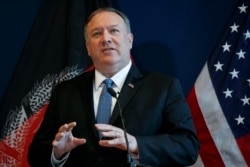The United States has publicly hailed its agreement with the Taliban as a "historic opportunity" to end the nearly 19-year war in Afghanistan.
But several crucial issues are either vague or entirely absent from the accord, prompting fears that the deal will not achieve a lasting peace in the country, which has been consumed by conflict for more than 40 years.
The deal signed on February 29 would allow U.S. President Donald Trump to fulfill his campaign pledge to stop "endless wars" and bring home thousands of U.S. troops during an election year.
But some experts have warned Washington made too many concessions to the Taliban without getting much in return. Many say the U.S.-negotiated agreement also undermines the Western-backed government in Kabul, which was not a party to the deal.
The agreement lays out a timetable for the full withdrawal of U.S. forces -- currently numbering around 12,000 -- out of Afghanistan by July 2021.
The pullout is dependent on the Taliban fulfilling its pledge to prevent terrorist groups from launching attacks against the United States and its allies.
The Taliban is also committed under the deal to hold direct negotiations with the Kabul government over a power-sharing arrangement. But it has thus far refused to do so.
No Explicit Taliban Renunciation Of Al-Qaeda
The deal falls short of a core U.S. demand: the Taliban publicly cutting its ties with the Al-Qaeda terrorist group.
The United States invaded Afghanistan in 2001 and ousted the Taliban after it refused to hand over Al-Qaeda leaders who were behind the September 11 terrorist attacks in the United States that killed nearly 3,000 people.
But the agreement only states that the Taliban "will not allow any of its members, other individuals, or groups, including [Al-Qaeda], to use the soil of Afghanistan to threaten the security of the United States and its allies."
It also says the Taliban must "send a clear message" to Al-Qaeda that they "have no place in Afghanistan," not to "cooperate" with them, to "prevent them from recruiting, training, and fundraising," and to "not provide visas, passports, travel permits, or other legal documents" allowing them to enter Afghanistan.
But the deal does not include an explicit Taliban commitment to break off ties with Al-Qaeda.
"Unlike the U.S., the Taliban wasn't in a rush to get a deal, and it could easily say no to demands it didn't like," Michael Kugelman, South Asia associate at the Woodrow Wilson International Center for Scholars in Washington, tells RFE/RL. "For the U.S., which badly needed a deal, getting the Taliban to agree to deny space to Al-Qaeda, without actually compelling the Taliban to sever ties with Al-Qaeda, was likely the best outcome it could get."
Al-Qaeda is a largely diminished force, with only several hundred fighters in Afghanistan, but remains a crucial part of the Taliban insurgency. The two groups have been longtime partners and are co-dependent, according to experts.
"In many Taliban units, it is often difficult to distinguish Taliban commanders from Al-Qaeda ones," wrote Javid Ahmad, a senior fellow at the Atlantic Council, and Husain Haqqani, director for South and Central Asia at the Hudson Institute. "The two groups enjoy multiple layers of top-down linkages," they wrote in The Washington Post. "The alliance is further tightened by intermarriages, and Al-Qaeda members often serve as religious mentors and instructors to the Taliban fighters."
General Kenneth McKenzie, head of the U.S. Central Command, said the Taliban had yet to show they are willing to take on Al-Qaeda. "That's something they're going to have to demonstrate that has not yet been demonstrated," McKenzie said on March 10.
U.S. Pullout Not Contingent On Peace
The United States has not tied its military pullout to the success of intra-Afghan peace talks over a permanent cease-fire and a power-sharing arrangement.
Instead, the withdrawal depends on the Taliban meeting its commitment to fight terrorism and the Islamic State (IS) extremist group.
U.S. officials have said the 14-month timetable for the withdrawal is "aspirational." U.S. Defense Secretary Mark Esper said the pullout was "conditions-based."
"If progress on the political front between the Taliban and the current Afghan government continues, then the United States and its partners will further reduce our presence toward a goal of zero in 2021," he wrote in The Washington Post on February 29. "If progress stalls, then our drawdown likely will be suspended as well."
But this point does not appear in the U.S.-Taliban agreement. According to the deal, the United States can withdraw even if the war between the Afghan government and the Taliban continues.
Considering the sensitivity of the issues and the chronic divisions among the Afghan political elite, many predict intra-Afghan negotiations to be complex and protracted, possibly taking years.
The talks were expected to start on March 10 but have been delayed due to disputes over the release of Taliban prisoners and the formation of Kabul’s negotiating team.
Ashley Jackson, a research associate at the Overseas Development Institute, a London-based think tank, says the U.S.-Taliban deal has the potential to be either the beginning of the end of the war in Afghanistan, or merely just the end of the U.S. military role in the war.
That depends, she says, on the process moving forward and intra-Afghan talks finally starting. "If not, and U.S. troops withdraw anyway as the agreement suggests they will, then it is little more than a withdrawal deal," Jackson says. "But it could also force all of the Afghan parties to get serious about talking to one another and support that process."
Nine former U.S. ambassadors and special envoys in Afghanistan penned a joint statement in September, warning that Afghanistan could collapse in a "total civil war" if the United States withdrew its forces before a "real" peace deal involving the Kabul government is reached with the Taliban.
No Mechanism to Verify Compliance
There is nothing in the agreement about how the United States will monitor and verify if the Taliban is sticking to its commitments, though the mechanism for verifying compliance may have been included in two classified annexes.
U.S. Secretary of State Mike Pompeo said there were two "military implementation documents" that were classified to "protect our soldiers." The documents are only available to members of the U.S. Congress.
The documents reportedly include military steps that should be taken over the next 18 months, what kind of attacks are banned by both sides, and how the United States will share information about its troop locations with the Taliban to prevent attacks during the withdrawal.
U.S. lawmakers who have reviewed the documents said there were insufficient mechanisms to verify if the Taliban is abiding by the deal and have accused the Trump administration of hiding details of the agreement from the public.
"If it's true that the secret annexes provide information on how the Taliban's obligations to the agreement will be monitored, it could be that the Trump administration fears the monitoring regime, if made public, would be perceived as too vague or weak and hence could provoke harsh criticism of the agreement," Kugelman of the Wilson Center says. "So long as the annexes remain secret, there will be fodder for conspiracy theories and concerns about transparency that will only heighten suspicions about the agreement and its intentions."
Chris Murphy of Connecticut, the top Democrat on the Senate Appropriations Committee and its Foreign Relations Committee, has reviewed the documents. He said the "security guarantees are so vague as to be effectively void. It's not clear how we will track whether they are indeed renouncing terrorist groups."
Even Liz Cheney (Republican-Wyoming), a Trump ally, said the deal failed to provide mechanisms to verify that the Taliban was keeping its promises. "My concerns still remain," she said, after studying the classified annexes.
No Reduction Of Violence
A weeklong reduction of violence preceded the signing of the U.S.-Taliban deal, with a significant drop in militant attacks.
But days later, the Taliban ordered its fighters to resume operations against Afghan forces, although not against foreign troops. The militants have since carried out scores of deadly attacks.
The warring sides are locked in a dispute about allowable levels of violence and attacks.
Afghan President Ashraf Ghani has said that Taliban attacks "violate" the U.S.-Taliban deal. The U.S. military has said it expects the violence to remain low and that violence escalation goes against the "spirit of the deal."
But the Taliban has said a reduction in violence was only a temporary confidence-building measure. And most importantly, the text of the U.S.-Taliban deal makes no mention of a Taliban commitment to reduce violence.
Jackson says the Taliban would not gain anything by reducing violence, the militant’s main source of leverage. "The Taliban may at some point agree to intra-Afghan talks and a more sustainable violence reduction in exchange for a legitimate stake in a national government," she says. "But until then I fully expect them to continue waging war."









